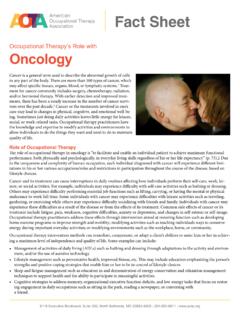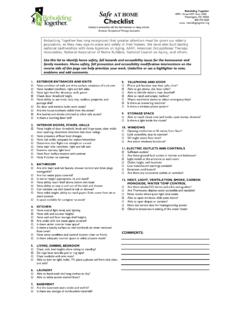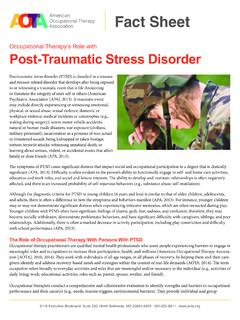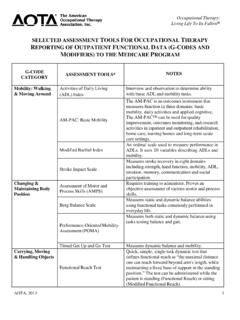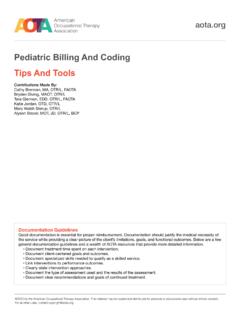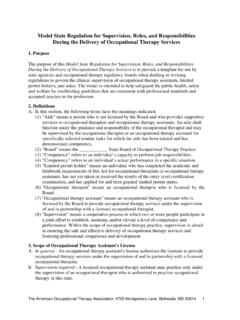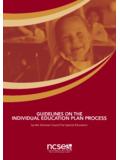Transcription of Occupational Therapy’s Role with Persons With Visual ...
1 Fact Sheet Occupational Therapy's Role with Persons With Visual Impairment million Americans report experiencing vision impairment or It is one of the top 10 disabilities among adults over age Aging is the single best predictor for experiencing Visual im- pairment; most Persons with Visual impairment are over age Older adults with Visual impairment are three to four times more likely than adults with normal vision to experience dif- ficulties completing activities of daily living (ADLs), such as preparing a meal, managing medications, and taking a Occupational therapy focuses on reducing the impact of dis- ability by promoting independence and participation in valued activities. Occupational therapy practitioners use the term occupation to represent activities that individuals need and/or want to do and that are meaningful to them.
2 The broad and comprehensive educational preparation of Occupational therapy practitioners enables them to address multiple dimensions of disability, including physical, psychological, cognitive, and social, that prevent children and adults from engaging in meaningful daily occupations. Practitioners work as members of a team of vision rehabilitation experts that may include optometrists, ophthalmologists, certified orientation and mobility specialists, vision rehabilitation therapists, certified low vision therapists, teachers of the visually impaired, and rehabilitation psychologists and counselors. What Is the Role of Occupational Therapy in Addressing Visual Impairment? Older Adults Occupational therapy practitioners work to ensure that older adults are able to age in place and participate in their communi- ties despite Visual impairment.
3 Occupational therapy practitioners are also part of coordinated rehabilitation teams that enable working age adults with Visual impairment to acquire or continue independent living and productive employment. As experts in activity analysis and environmental modification, Occupational therapy practitioners determine how vision impair- ment has limited the person's ability to complete specific daily tasks. The practitioner then modifies the task and/or the environ- ment to minimize or remove those limitations. For example, an Occupational therapy practitioner might restructure a task to remove a vision-dependent step, such as programming a telephone to speed dial emergency numbers. The Occupational therapist also carefully evaluates the environments where the person completes activities to determine those things that facilitate or inhibit participation, safety, and independence, then provides recommendations and modifications.
4 For example, the therapist may rec- ommend adding lighting and contrast to increase visibility in the environment or removing a hazard to reduce the risk of falls. Occupational therapy practitioners also apply their expertise with adaptive devices and assistive technology to enable older adults to use optical and non-optical devices to complete ADLs. The practitioner, for example, may work with the person to use a prescribed optical device such as a hand-held magnifier to complete shopping, or a non-optical device such as a talking glucom- eter to complete diabetes self-management. Occupational therapy practitioners also work with Persons to use their remaining vision as efficiently as possible to complete ADLs. This may include teaching a person with central vision loss how to use another part of the retina to see letters more clear- ly when reading a medication label, or teaching a person who has lost vision on one side from a stroke to scan the environment more quickly and completely on the blind side to avoid missing objects, which may hinder safety or the ability to read print.
5 6116 Executive Boulevard, Suite 200, North Bethesda, MD 20852-4929 | 301-652-6611 | Traumatic Brain Injury Occupational therapy practitioners are recognized experts in addressing the vision processing deficits that occur from traumatic brain injury (TBI). Practitioners provide interventions to improve Visual attention, search and speed, and efficiency in Visual processing. They work closely with optometrists and ophthalmologists to ensure that clients with TBI are able to compensate for deficits in acuity, Visual field, and eye movements to complete important daily activities safely and effectively. Driving Adults with stable vision impairments benefit from the unique Occupational therapy expertise in driving assessment. Occupa- tional therapists trained in driving rehabilitation are recognized experts in this area and address all aspects of driving, including initial driving evaluation, training and adaptations to enable the person to drive safely, or education on how to maintain com- munity mobility if resumption of driving is not a realistic goal.
6 Occupational therapists also provide evaluation and training in the use of prescribed bioptic lenses for driving with central field deficit. Children Children can have either cortical Visual impairment (CVI; affecting areas of the brain that process Visual information) or ocular Visual impairment (affecting the eyes). CVI is now the leading cause of Visual impairment in children. Children with either CVI. or ocular impairment benefit significantly from coordinated and comprehensive services to enable them to learn to use their remaining vision more efficiently and learn nonvisual methods to complete activities. Occupational therapy practitioners work as members of comprehensive rehabilitation teams to address development of gross and fine motor abilities, spatial awareness, and ADLs such as feeding, toileting, dressing, and engaging in play.
7 They work with teachers of the visually impaired and other educators to ensure that the child is able to participate fully in the classroom. The Occupational therapy practitioner also assists in the child's transition into adult life, including vocational preparation and community living. Where Are Services Provided? Occupational therapy services for Persons with low vision may be provided in any setting, including early intervention envi- ronments, schools, skilled nursing or other extended care facilities, rehabilitation centers, specialty clinics, community-based programs, and the person's home. Who Pays for Occupational Therapy Low Vision Services? Most private health insurance programs cover Occupational therapy services for disabilities, including low vision. Medicaid covers Occupational therapy services on a state-by-state basis.
8 Medicare extended coverage of low vision rehabilitation services provided by Occupational therapists to all beneficiaries in 2002. Referral by an optometrist or physician is required for Medicare Children with vision impairment may receive services in educational settings under the Individuals with Disabilities Education Act (IDEA). References Ryskulova, A., Turczyn, K., Makuc, D. M., Cotch, M. F., Klein, R. J., & Janiszewski, R. (2008). Self-reported age-related eye disease and Visual impairment in the United States: Results of the 2002 national health interview survey. American Journal of Public Health, 98, 454 461. Centers for Disease Control and Prevention. (2001). Prevalence of disabilities and associated health conditions among adults United States, 1999. MMWR, 50(7), 120 125. National Eye Institute ( ) What you should know about low vision.
9 Retrieved February 17, 2011, from Crews J. E., & Campbell, V. A. (2004). Vision impairment and hearing loss among community-dwelling older Americans: Implications for health and functioning. American Journal of Public Health, 94, 823 829. Centers for Medicare & Medicaid Services. (2002). Program memorandum. Retrieved June 28, 2007, from Developed by Mary Warren, MS, OTR/L, SCLV, FAOTA, and Linda Baker Nobles, MS, OT/L, for the American Occupational Therapy Association. Copyright 2011 by the American Occupational Therapy Association. This material may be copied and distributed for personal or educational uses without written consent. For all other uses, contact Occupational therapy enables people of all ages live life to its fullest by helping them to promote health, make lifestyle or environmental changes, and prevent or live better with injury, illness, or disability.
10 By looking at the whole picture a client's psychological, physical, emotional, and social make-up Occupational therapy assists people to achieve their goals, function at the highest possible level, maintain or rebuild their independence, and participate in the everyday activities of life.
